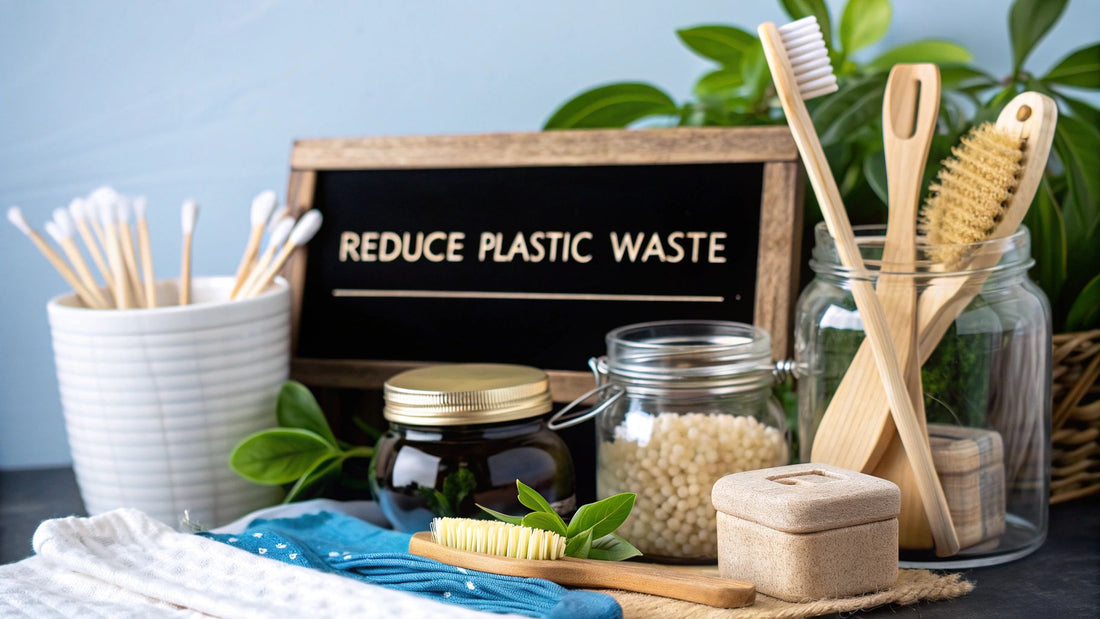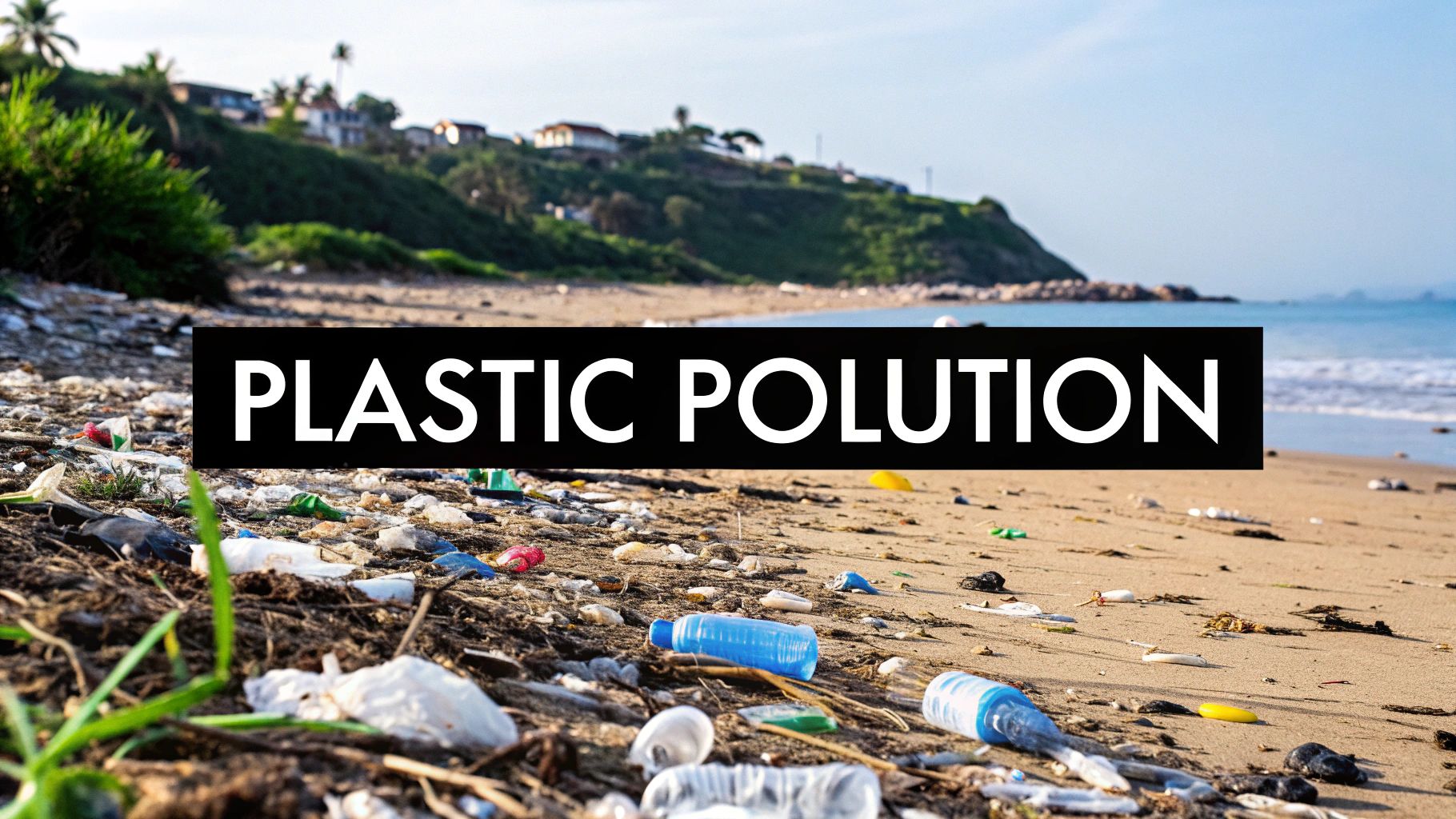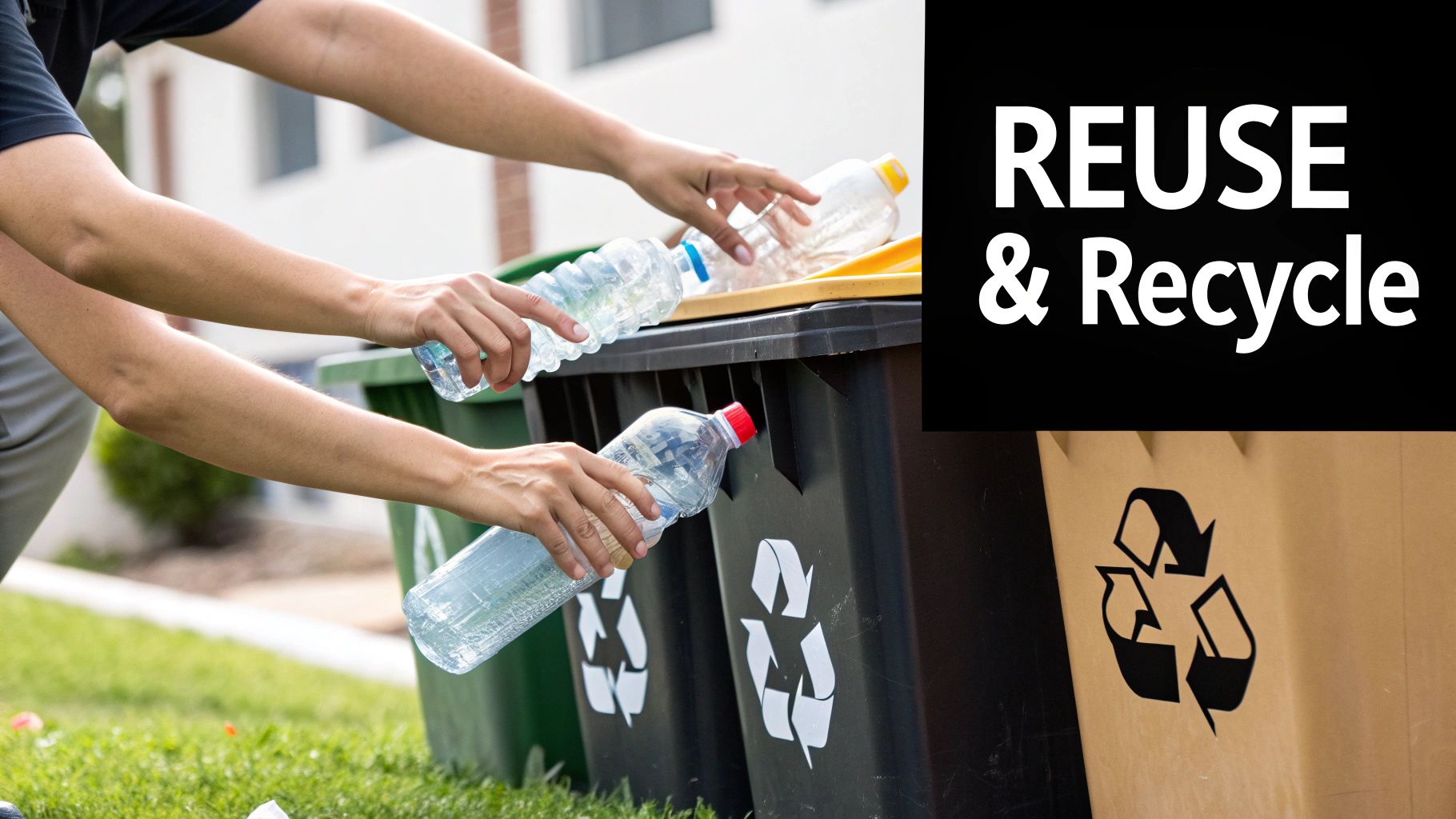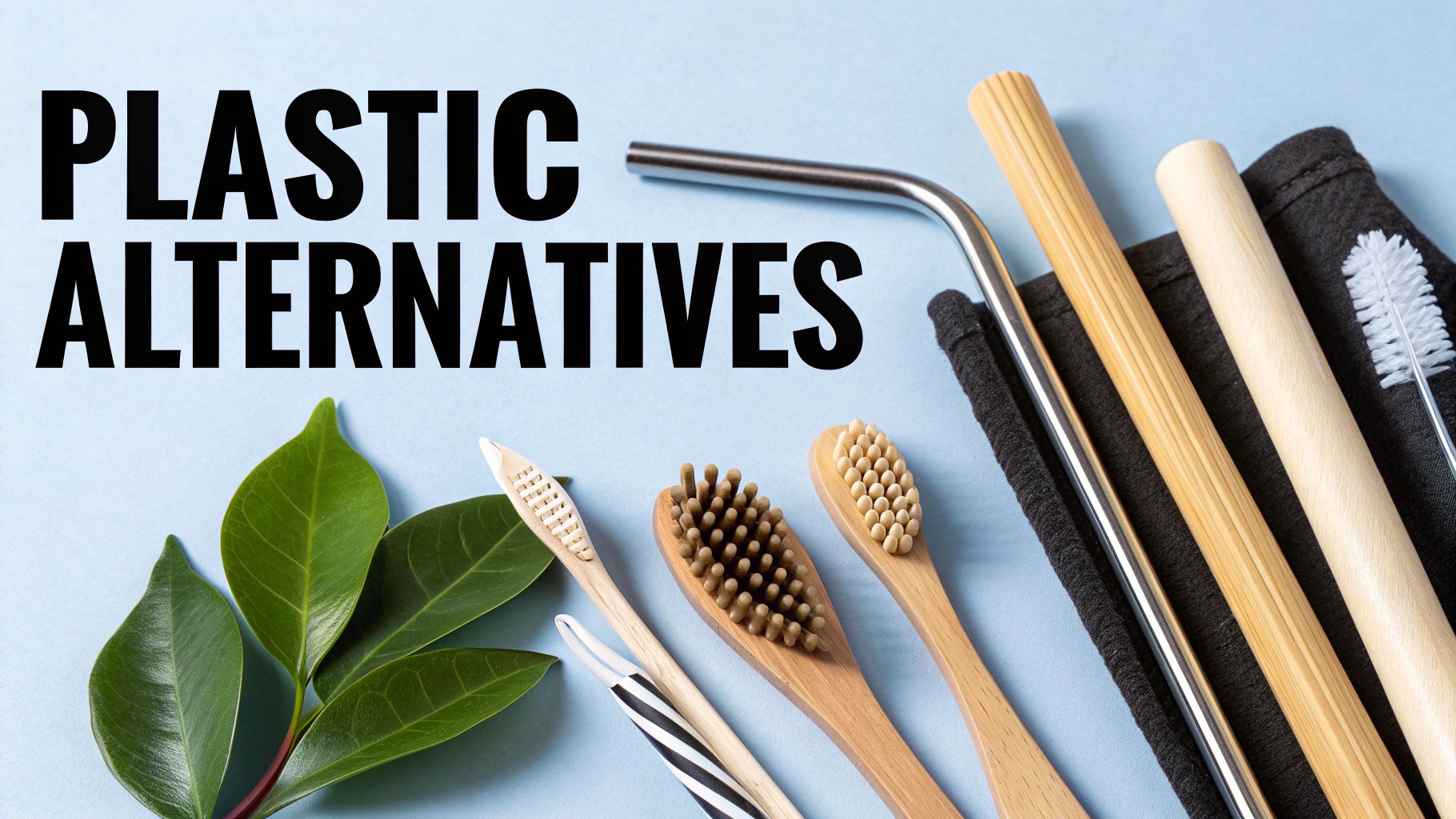
Your Choices Can Change the World: A Practical Guide to Reducing Plastic Waste
Share
Let's be clear: figuring out how to reduce plastic waste is not just about eco-friendly tips. It’s about recognizing one simple, powerful truth: your daily choices have the power to change the world. The overwhelming plastic crisis we face was built from billions of individual actions. This means it can be dismantled the same way. Every single time you choose a reusable item over a disposable one, you are casting a vote for a healthier planet. You are part of the solution.
Why Your Choices on Plastic Are Not Small—They Are Everything
It's easy to fall into the trap of thinking, "What difference can one person possibly make?" Let’s follow the journey of a single plastic water bottle. It begins its life as a fossil fuel, its creation pumping carbon into our atmosphere. You use it for a few fleeting minutes, then toss it. In the best-case scenario, it might find its way to a recycling plant. More often, it’s destined for a landfill, where it will lie dormant for centuries, a monument to a moment of convenience.
And the worst case? It washes into a river and is carried out to the ocean, joining a tidal wave of debris.

This isn’t a hypothetical story; the scale of this reality is staggering. Since the 1950s, humans have produced over 8 billion tons of plastic. Of that colossal amount, a mere 9% has ever been recycled. When this waste floods our environment, the fallout is devastating, especially for marine life. In one heartbreaking case from 2019, a whale was found dead in the Philippines with 88 pounds of plastic bags clogging its stomach. You can confront more of this stark data on worldpopulationreview.com.
The Undeniable Power of Collective Action
This is precisely where your personal commitment transforms into an unstoppable force. When millions of us—people just like you—decide to refuse a plastic bag, bring our own coffee cups, or actively choose products with less packaging, the ripple effect is immense.
The most effective strategy to defeat the plastic crisis is to cut it off at the source. When you and millions of others reduce your personal plastic use, you create an undeniable demand for sustainable alternatives that businesses cannot ignore.
This collective pressure sends a clear, powerful signal to manufacturers and retailers: we demand less plastic. It forces innovation and pushes companies to completely rethink how they design, package, and sell their products.
Shifting from Helplessness to Empowerment
The goal of understanding this problem is not to burden you with guilt. It is to arm you with purpose. It is to show you the incredible power you hold in your hands every single day. Every small change you make is a victory. Each step you take to eliminate plastic from your kitchen, your bathroom, and your daily life is a crucial part of a global solution.
Your journey to a low-plastic life isn't about achieving perfection. It’s about acting with intention. By focusing on simple, manageable swaps, you’re not just cleaning up your own footprint—you are actively building a new normal where convenience no longer costs us the health of our planet.
Your Action Plan: Reclaiming the Kitchen from Plastic
The kitchen is the heart of the home, but let's be honest—it’s also ground zero for the invasion of single-use plastic. It's in the wrap clinging to our cheese, the bags holding our snacks, and the countless bottles lining our fridge doors. Convenience has a price, and in the kitchen, it looks like a mountain of plastic waste. But this also means your kitchen is the most powerful place to start making a real, tangible impact.
Don't fall for the trap of thinking you need a complete, all-or-nothing overhaul overnight. That's a recipe for burnout. The most effective approach begins with a simple, no-judgment audit. Open your fridge, pantry, and cabinets. What do you see? Plastic-wrapped vegetables, disposable coffee pods, single-serving yogurt cups? This isn't about guilt. It's about gathering intelligence—identifying your plastic sources so you know exactly where to strike first.
Starting with Simple, Powerful Swaps
Once you’ve identified your personal plastic hotspots, you can begin making strategic trades. The key is to think long-term. Swap disposable items for durable, reusable ones. This simple shift in mindset doesn't just slash your waste; over time, it will save you a surprising amount of money.
Consider your daily routine. That morning coffee is a perfect example. If you rely on a pod machine, you can switch to a classic French press or a reusable pod filter. A single person using disposable pods can generate over 10 pounds of plastic waste every year. When you pack a lunch, ditch the flimsy plastic sandwich bags for reusable silicone ones or a classic lunch box.

You see? A few mindful swaps truly do add up, empowering you to eliminate a massive chunk of the plastic waste an average person creates annually.
Rethinking How You Shop and Store
How you store food is another huge opportunity for change. Instead of instinctively reaching for plastic wrap to cover leftovers, try beeswax wraps or simply place a plate on top of the bowl—it’s just as effective. When it comes to storage containers, glass is a vastly superior alternative to plastic. Glass containers don't absorb stains or smells, won't leach chemicals into your food, and can last a lifetime.
To help you start, here is a quick guide to some common kitchen culprits and their far more sustainable counterparts.
Simple Kitchen Swaps to Reduce Plastic Waste
| Common Plastic Item | Sustainable Alternative | Why It's a Better Choice |
|---|---|---|
| Plastic Wrap | Beeswax Wraps or Silicone Lids | Reusable and washable, keeping food fresh without generating endless waste. |
| Ziploc Bags | Reusable Silicone Bags | Durable and versatile for snacks, sandwiches, and freezer storage. One bag replaces hundreds. |
| Plastic Cutting Boards | Wood or Bamboo Cutting Boards | Longer-lasting, naturally antimicrobial, and won’t shed microplastics into your food. |
| Plastic Produce Bags | Reusable Mesh or Cloth Bags | Lightweight and easy to bring, allowing you to refuse those flimsy single-use bags at the store. |
| Plastic Water Bottles | Stainless Steel or Glass Bottle | A one-time purchase that prevents hundreds of plastic bottles from polluting our planet. |
These changes, which may feel small initially, create a powerful ripple effect that drastically reduces the plastic entering and leaving your home.
Of course, your habits at the grocery store are as critical as your actions in the kitchen.
- Bring Your Own Bags: And not just the large totes. Keep smaller mesh or cloth bags handy for produce and bulk items. It’s an easy, decisive way to refuse countless flimsy plastic bags.
- Embrace the Bulk Bins: The bulk section is your ally. Buying rice, nuts, grains, and spices this way lets you fill your own containers, eliminating packaging entirely.
- Choose Glass or Metal: When you have the option, always choose products packaged in glass or metal. Think pasta sauce in a glass jar or olive oil in a tin. These materials have far superior recycling rates than plastic.
The most powerful strategy for a low-plastic kitchen is prevention. By thinking ahead and choosing reusability, you stop plastic waste before it even has a chance to enter your home.
And for those unavoidable food scraps, your choices still matter profoundly. Instead of tossing them in a plastic trash bag bound for a landfill, put them to work. For anyone ready to embrace composting, using the right bags is a game-changer. Learn more about the incredible benefits of using compostable bags for food waste in our detailed guide. It’s a rewarding way to turn kitchen scraps back into valuable nutrients for the soil, truly closing the loop on waste.
Decluttering Plastic from Your Bathroom for Good
While the kitchen gets a lot of attention, our bathrooms are often just as saturated with plastic. Take a moment to scan your shower and countertops. Chances are you’ll see a landscape of plastic bottles, tubes, and containers for shampoo, conditioner, body wash, and toothpaste. Every single one of those items will outlive us by centuries, lingering in our environment.
The inspiring news is that transitioning your personal care routine away from plastic is not only simple—it’s empowering.

This is about more than just figuring out how to reduce plastic waste. It’s about cultivating habits that are better for you and the planet. Many plastic-free products also eliminate the harsh chemicals common in mainstream brands. You’re not just clearing plastic from your shelves; you're decluttering your body, too.
Easy Swaps for a Powerful Daily Routine
There’s no need to throw everything out at once. A far more practical and budget-friendly method is to replace items as they run out. This gradual transition makes the entire process feel natural and sustainable in the long run.
The shower is the perfect place to start. Solid shampoo and conditioner bars are revolutionary. I’ve found that one bar can easily last as long as two or three plastic bottles, saving you a surprising amount of money and eliminating a huge amount of waste. Plus, they are a traveler's dream—no more liquid restrictions at the airport.
A simple switch to bar soap, shampoo, and conditioner can prevent dozens of plastic bottles from entering the waste stream each year, per person. This small change has a massive cumulative impact.
In the same spirit, switching from a plastic bottle of body wash to a classic bar of soap is one of the easiest and most effective swaps you can make. You can find them with minimal paper packaging or even entirely package-free.
Upgrading Your Oral Care
Think about your dental hygiene—a daily ritual that, when multiplied across billions of people, creates a staggering amount of waste. We are talking about billions of plastic toothbrushes discarded every single year, piling up in landfills and polluting our oceans.
Here are a few simple yet powerful upgrades:
- Bamboo Toothbrushes: This is a brilliant alternative. The handle is compostable; just remove the nylon bristles with pliers before adding it to your compost bin.
- Toothpaste Tablets: Ditch the impossible-to-recycle toothpaste tube for these innovative tablets. They typically come in refillable glass jars, work just as effectively as paste, and are incredibly convenient.
- Refillable Floss: Most dental floss is plastic string in a plastic box. Seek out options made from silk or corn fiber that come in a small, refillable glass dispenser.
These changes might feel small in isolation, but when millions of us adopt them, we stop a tidal wave of plastic from ever being created.
Beyond the Basics
Once you have the major items covered, you can start looking for other opportunities. A reusable safety razor is an excellent investment. While the initial cost of the handle is higher than a disposable, the replacement blades are incredibly cheap, saving you a lot of money over time. Deodorant is another easy swap, with more and more brands offering effective formulas in cardboard tubes or sleek, refillable cases.
You can even get creative and make some products yourself. A simple body scrub made from sugar or coffee grounds mixed with coconut or olive oil works wonders. It's a fantastic way to avoid plastic packaging and the harmful plastic microbeads found in many store-bought exfoliants.
Don't forget to seek out local co-ops or zero-waste stores for refilling items like liquid hand soap and lotions. These shops are emerging everywhere and allow you to bring your own containers, eliminating packaging entirely. By embracing these changes, your bathroom can become a quiet, powerful testament to a cleaner, more intentional way of living.
Maintaining a Low-Plastic Lifestyle in a High-Plastic World

It’s one thing to get your kitchen and bathroom in order, but the real test often begins the moment you step outside. Our world is engineered for convenience, and that usually means a torrent of single-use plastic, from morning coffee cups to last-minute takeout containers. Learning how to cut down on plastic waste when you're out is simply about building new, better habits.
This isn't about perfection; it's about preparation. The most powerful tool you can have is a simple ‘zero-waste kit.’ You don’t need anything fancy, just a few key items stashed in your car, backpack, or bag.
The secret to defeating convenience plastics is to make the alternative just as convenient. A well-stocked 'on-the-go' kit removes the guesswork, empowering you to make sustainable choices anytime, anywhere.
This simple act of planning makes a world of difference. Global plastic production soared to 436 million metric tons in 2023, and a staggering 75% of all plastic ever made has already become waste. Even more shocking, the equivalent of over 2,000 garbage trucks full of plastic floods our water systems every single day, with single-use packaging as a primary culprit. You can dive deeper into the grim reality of the environmental impact of plastic pollution to fuel your resolve.
Assembling Your Essential Go-Kit
Your kit can be as basic or as comprehensive as you wish. The goal is simply to have the essentials on hand so you’re never caught without a plastic-free option. I recommend starting with the basics and adding items as you discover what you truly need.
A powerful starting point includes:
- A Reusable Water Bottle: This is non-negotiable. It's the single easiest swap to eliminate your consumption of plastic water bottles forever.
- A Reusable Coffee Cup: If you are a regular coffee or tea drinker, this is a must-have. Many cafes will even give you a discount for bringing your own cup.
- A Set of Cutlery: A simple bamboo or stainless steel set with a fork, spoon, and knife in a small pouch is perfect.
- A Foldable Shopping Bag: These pack down so small you can tuck one into a pocket or purse, ready for any unexpected purchase.
Navigating Real-World Scenarios
Having the kit is one thing; using it confidently is another. It might feel a bit awkward at first to make a special request, but trust me, a polite and friendly approach works wonders.
For instance, when ordering takeout, just ask, "Would it be okay for you to pack my order in this container I brought?" Most businesses are happy to accommodate. When getting a drink, a simple and firm "No straw, please" is all it takes. The more people who do this, the more normal it becomes for everyone.
When it comes to snacks, a little planning goes a long way. Packing a piece of fruit, a handful of nuts from your bulk supply, or a homemade granola bar helps you sidestep the temptation of plastic-wrapped convenience foods. By building these small habits, you’ll quickly discover that living a low-plastic life on the go is not just possible—it’s liberating.
Driving Change Beyond Your Household: Your True Power
Taking personal responsibility to reduce plastic is the essential first step. It is where this crucial journey begins. But to win this fight, we must think bigger.
To achieve real, lasting progress in how to reduce plastic waste, we must expand our focus from just managing our personal trash to challenging the system that produces so much of it in the first place. This is where you, as a consumer and a citizen, hold immense power.
Wielding Your Influence as a Consumer
Think about where you spend your money each week—your local grocery store, the corner coffee shop, your favorite takeout spot. Your voice is a powerful tool for change in these places. A simple, friendly conversation can plant a seed that grows into meaningful action. Never hesitate to ask for more sustainable options.
Next time you're out, start a conversation:
- "Have you ever considered adding a bulk bin section so we can buy things like grains and nuts without packaging?"
- "Would you consider offering paper bags for produce as an alternative to plastic?"
- "I love your products, and I would buy them even more often if they came in plastic-free packaging."
Your choices send an undeniable economic signal. When you consistently support businesses that prioritize sustainability and you vocally request plastic-free alternatives, you are not just one person. You are part of a growing wave of consumer demand that businesses cannot afford to ignore.
This is about being proactive. Instead of passively accepting the plastic we're given, we can actively influence the choices available to everyone. You are helping create real demand for a circular system where waste is designed out from the beginning. While you push for these bigger changes, you can manage your home's waste more sustainably with tools like the best compostable trash bags for your organic scraps.
Advocating for System-Wide Change
It's also crucial to understand the bigger economic forces at play. A primary reason plastic is ubiquitous is because it's artificially cheap, which puts sustainable alternatives at a severe disadvantage. A major driver of this is the imbalance in global trade tariffs.
Over the past three decades, tariffs on plastic products have plummeted to around 7.2%. Meanwhile, eco-friendly materials like paper and bamboo can face tariffs that are double that, averaging 14.4%. This financial barrier makes it incredibly difficult for greener options to compete. You can learn more about how trade policies impact plastic pollution on unctad.org.
Supporting policies that level this playing field and hold producers financially responsible for their packaging—a system known as Extended Producer Responsibility (EPR)—is how we create change on a massive scale. Your personal journey to reduce plastic waste gives you the experience and credibility to champion these larger solutions. It transforms your individual effort into a powerful force for a healthier planet.
So, you’re ready to cut down on plastic. That’s a powerful decision. But as you begin, it's natural for questions and doubts to arise. It's normal to wonder if your efforts are practical or if they're truly making a difference.
Let's address some of the most common concerns head-on. Conquering these doubts from the start will give you the confidence to build momentum and stick with it for the long haul.
Is Recycling Really the Answer to the Plastic Crisis?
This is a critical question, and the blunt answer is no. While recycling is certainly better than sending plastic to a landfill, it is nowhere near a complete solution.
Here is the sobering reality: a staggering 9% of all plastic ever produced has actually been recycled. Most plastic is either too complex, contaminated, or costly to process, and the recycling system itself is energy-intensive.
This is precisely why the mantra is "Reduce, Reuse, Recycle"—in that order of importance.
The single most powerful action you can take is to focus on reducing your plastic consumption from the start. This prevents waste from ever being created, which is an infinitely greater victory than trying to manage it after the fact.
When you cut back, you are sending a direct economic signal to decrease the demand for new plastic production.
Can I Really Do This on a Budget?
It is a pervasive myth that living with less plastic will drain your bank account. While some reusables have an upfront cost, they almost always save you money—often a significant amount—in the long run. Think about it: one high-quality water bottle can replace hundreds, if not thousands, of single-use plastic ones.
The key is to start with simple swaps that have a big financial and environmental payoff:
- Make it a non-negotiable habit to bring your own bags to the grocery store.
- Brew your coffee at home instead of buying it in a disposable cup.
- Purchase staples like oats, rice, and beans from bulk bins—it's almost always cheaper per pound.
Living with less plastic often means returning to simpler, more frugal habits. It’s a win-win for your wallet and the planet.
What if I Can't Find Plastic-Free Options Where I Live?
This is a real and frustrating challenge for many. If your local stores have limited options, do not let it discourage you. Start with what you can control.
Focus on actively refusing things you don’t need, like plastic straws, disposable cutlery with takeout, or an extra plastic bag for a single item. Your voice as a customer is also a powerful tool. A polite conversation with a store manager about your desire for more plastic-free products can plant an important seed. Sometimes, they simply need to know that the demand exists.
For everyday items like trash bags, it’s worth exploring better alternatives. To learn more, you can discover what are compostable bags and see how they can fit into your new, more sustainable routine.
Ready to take the next step on your low-waste journey? terravera offers high-quality, certified compostable bags and natural oils to help you reduce plastic and live more sustainably. Discover our collection and join the movement today at https://www.myterravera.com.
